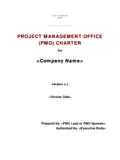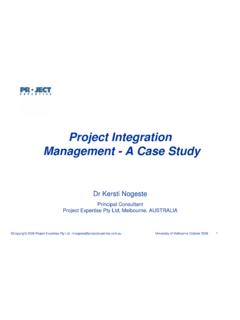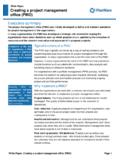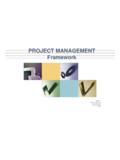Transcription of PMO Best Practices - PA&E Global
1 IT 2010, T. K. Gaughan, PMP IT Process Architects & Engineers Global Services, LLC 1 The project management office (PMO) best Practices and Processes There are two (2) standard project management office (PMO) models: Administrative and Functional. The key difference between the two is ownership in terms of Accountability. The Administrative PMO is responsible for maintaining the approved policies, processes, and procedures commonly applied across all programs/projects, as well as the centralized project Administration support necessary to ensure consistent implementation. A Functional PMO, on the other hand, is an organizational activity that assigns the project Manager (PM) resources responsible for program/ project cost, schedule, and technical/quality performance. It is important to note that a Functional PMO also performs all of the functions of an Administrative PMO, including assignment of a project Administrator.
2 The primary reasons for implementing a PMO include: Efficiency making optimal use of available resources; Effectiveness ensuring project management processes are delivered in a correct, consistent, and timely manner; and IT Governance providing the leadership, organizational structure, regulations, standards and processes that ensure projects comply with best Practices in accordance with the enterprise charter/mission, strategies, and business objectives Regardless of whether it follows an Administrative or Functional model, the PMO serves as a mechanism for satisfying six (6) standard process control objectives: Process Owner designates an owner for each project management process so that performance responsibility is clear Process Repeatability project management processes are defined and yield consistent process results/outcomes Clear Goals and Objectives establishes clear goals and objectives for effective execution of each project management process Assigned Roles and Responsibilities defines unambiguous roles, activities, and responsibilities for each project management process to ensure efficient execution Process Performance Evaluation objectively measures the performance of each project management process against defined goals and objectives Approved Policy, Plans, and Procedures documents, reviews, approves, and communicates to all stakeholders the applicable policy, plan.
3 And procedure/work instructions that drive each project management process Whether a PMO has an Administratve or Functional role, the accountable PM is responsible for implementing project management best Practices and procedures for the Company. Regardless of the project -specific technical focus, IT projects should utilize PM processes compliant with best Practices as prescribed by the project management Institute (PMI ), as well as Engineering management processes compliant with best Practices as prescribed by the Institute of Electrical and Electronics Engineers (IEEE ), American National Standards Institute (ANSI ), and the Software Engineering Institute (SEI ) for software development. IT 2010, T. K. Gaughan, PMP IT Process Architects & Engineers Global Services, LLC 2 At PA&E Global we know from experience that for any project to be successful it needs mature and effective project management policies, processes, and procedures.
4 Our PMs have successfully managed Information Technology (IT) Projects applying a disciplined System Development Life Cycle (SDLC) approach for hundreds of multi-disciplinary efforts, from Requirements Definition through Planning, Design, Development, Implementation, and ongoing Operations and Maintenance. In addition to knowledge and experience in all of the standard project processes and Practices , the skill set required of our PMs includes: Senior management knowledge and leadership; Use of PM tools ( , MS project ); Communications management Practices that engage the project Team, Sponsor and other Key Stakeholders; Change management and Configuration management standards and Practices ; Quality management methods and Practices ; project Control applying Earned Value management System (EVMS) Practices ; and A positive value proposition by consistently delivering project performance on time, on quality, and within budget.
5 project Planning For the PMO and PM to be successful, all activites, goals, milestones, and schedules must be documented in a project Plan. project Plans are based on the Work Breakdown Structure (WBS), which identifes the activities necessary to deliver the highest value project work products and performance. The WBS defines the total project work scope, and each descending level of the WBS represents an increasingly detailed definition of the work to be performed. The WBS provides the project scope definition foundation for resource and performance planning, time and cost estimating, budget formation, and progress/performance tracking and reporting. Communications management Effective communications are a key factor in project success. project communications best Practices include periodic project Team meetings, regularly scheduled Client meetings and formal reviews and audits, and submission of regular ( , monthly) Cost and Schedule Status Reports (CSSRs).
6 To facilitate communication among the project Team members and timely service delivery to Clients, a PMO can employ a variety of collaboration tools, including SharePoint, project Server, Exchange Server, and even FTP. Change management All projects require Change management Practices that provide written procedures and work instructions for managing change. Configuration management is a functional elemet of Change management that encompases Configuraton management (CM) Planning, Configuration Identification, Configuration Control, Configuration Status Accounting, and Configuration Audits and Reviews ( , configuation validation). A mature PMO uses documented Change IT 2010, T. K. Gaughan, PMP IT Process Architects & Engineers Global Services, LLC 3 management processes and procedures that are compliant with recognized industry standards and best Practices .
7 These processes and procedures ensure a proven effective and auditable method for managing all types of changes, including project scope, work products, and organizational and business process change. PA&E Global helps Clients implement best Practices by applying our established Quality Procedures (QPs) for Configuration management . For example, our CM QPs provide a template of step-by-step instructions for a Configuration Control Board (CCB - see Exhibit 1 below). In software development environments, we recommend utilizing rules-based Change management process tools that maximize automation of process functions. Exhibit 1- Configuration Control Board (CCB) Process Flow Quality management Our recommended approach to Quality management as part of PMO best Practices is a project Deliverables management (PDM) process (see Exhibit 2 below).
8 This process applies to all project work products, regardless of type ( , text documents, website graphics, software applications, etc.). The process utilizes Peer Review and Client Review as the inherent methods for Quality Assurance/Quality Control (QA/QC) of each deliverable. Deliverables ( , Master Original releases and associated hardcopy and softcopy artifacts)are archived in a CM Library and recorded/indexed in a CM Database (CMDB), thus enabling each approved change to be closely controlled, verified and consistently recreated ( , repeatable). We ensure Clients can maintain positive control of quality by helping design and develop project processes that include: Mature, proven, and effective project Deliverables management ; Peer reviews of designs and deliverables for objective quality validation and verification, and to facilitate professional consensus on technical accuracy among Subject Matter Experts (SMEs); and IT 2010, T.
9 K. Gaughan, PMP IT Process Architects & Engineers Global Services, LLC 4 Designating the PM as the single Release Authority with ultimate responsibility and accountability for approval f the project Team s work quality. Exhibit 2 project Deliverables management (PDM) Process Flow Risk management For any project , management of risks is an important part of controlling changes to scope and cost (see Risk Score Matrix in Exhibit 3 below). As a basic approach, PA&E Global helps Clients implement a Risk management process that applies both Qualitative and Quantitative Risk Assessment techniques. Our Principal Consultants have an extensive knowledge base of subject matter expertise and experience utilizing Risk management best Practices , including maintaining recodes in a project Risk Register.
10 All members of the project Team (including Customer staff) should be proactive participants in vigilantly monitoring the project risk horizon for the onset of known and/or previously unforeseen project risk events. IT 2010, T. K. Gaughan, PMP IT Process Architects & Engineers Global Services, LLC 5 Exhibit 3 - Risk Score Matrix Earned Value management System Cost and Schedule Control For any project , best Practices require accounting for expenditure of budgeted costs. PA&E Global helps Clients implement Earned Value management System (EVMS) processes that ensure auditable compliance with best Practices as prescribed by ANSI/EIA-748-A (American National Standards Institute/Electronic Industries Alliance Standard for Earned Value management Systems). Properly implemented EVMS processes include cost and schedule performance measurement, reporting, analysis and decision making.






